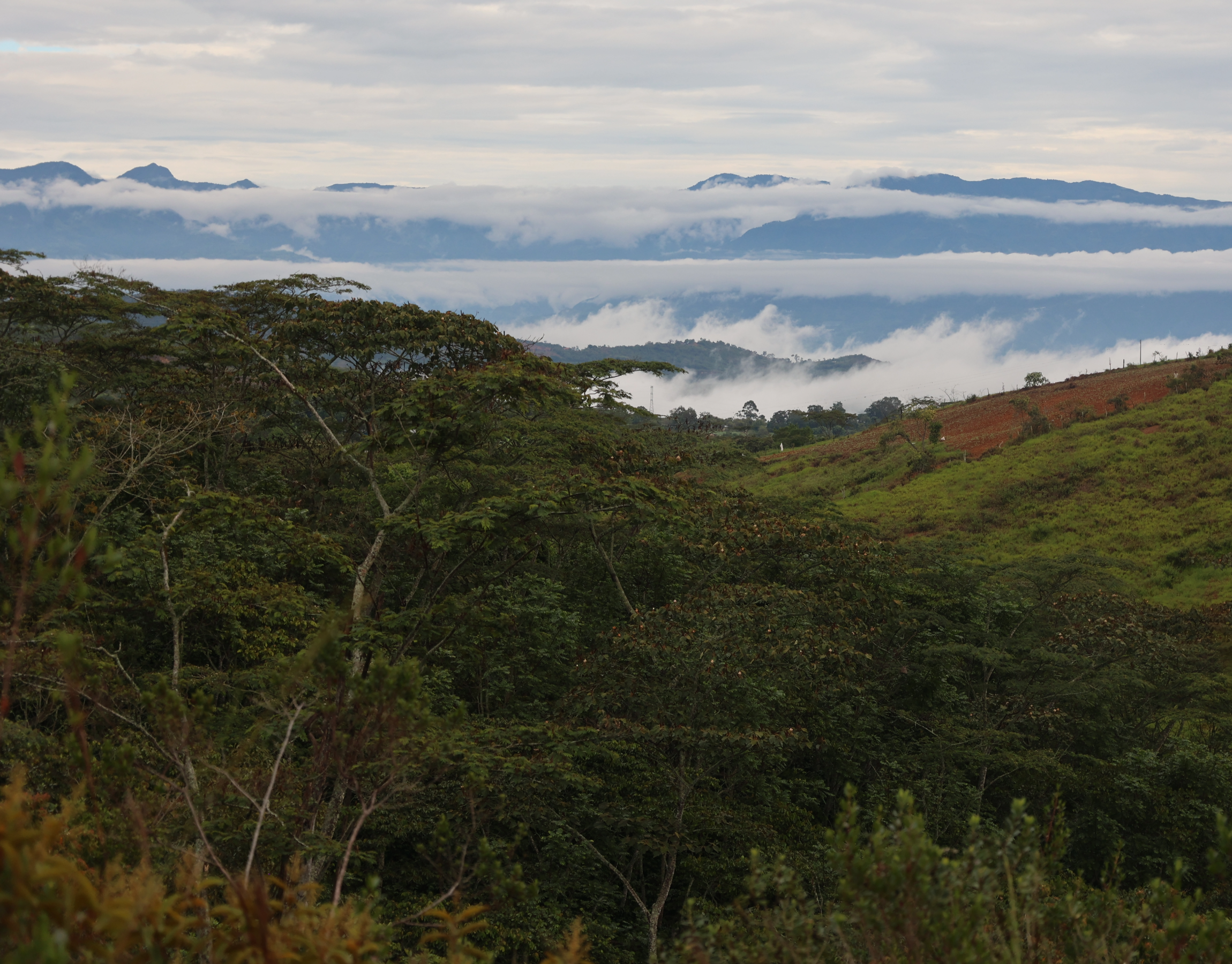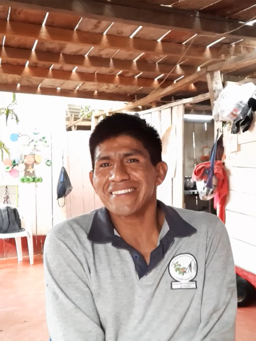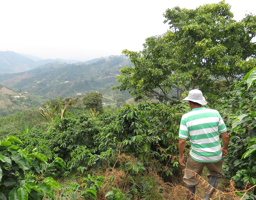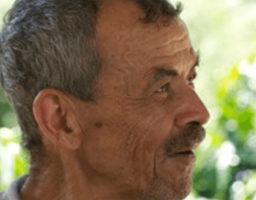Colombia
Identity record

Capital city
Bogota Coffee area
840,112ha Average farm area
1.56ha Geography
A wide diversity of mountainous Harvest period
October - January Secondary harvest
May - June Number of coffee growers
600000 Number of people living from the coffee industry
540000 Number of harvests per year
2 Bag production per year
14000000 Main varieties
Bourbon, Castillo, Catimor, Caturra, Cenicafe, Colombia, Geisha, Tabi, Typica
Coffee production areas
Click on the area you want to observe

Antioquia
Antioquia's economic and social landscape is structured by the long-established cultivation of coffee. The region is characterised by great geographical diversity, with virtually all the country's features represented: sea, plains, mountains, highlands, swamps, rivers, marshes and forests. Crossed by two branches of the Andes, the Cordillera Occidental and the Cordillera Central, it was in this region that coffee was introduced to Colombia over 180 years ago.
Today, Antioquia is the country's main coffee-growing region. With more than 128,000 hectares dedicated to coffee, the region produces a wide variety of coffees thanks to its many microclimates and terroirs. The department has 117,000 hectares of plantations, making it the second largest producer in the country. There are also 95,553 coffee farms and 76,543 growers in the region. These figures underline the vital importance of this industry to the local economy.

Cauca
The Cauca region, located in the south-west of Colombia, covers an area of 29,308 km², or 2.56% of the national territory. It has played an important role in the country's historical development, both economically and politically, from colonisation to independence in 1810. Home to some of Colombia's most impressive volcanoes, Cauca benefits from fertile and rich volcanic soil, making it a key region for coffee cultivation.
Socially, Cauca is one of the most complex departments in the country. Its territory was inhabited in pre-Hispanic times by various indigenous groups such as the Jamundies, Pances, Paeces, Calotos, Patías, Guambianos and Guanacas. Today, the western descendants live mainly in the capital, Popayan, while the indigenous peoples occupy the mountainous and remote areas.
Cauca is a leader in the production of high quality coffee. Thanks to its climate, its varied topography influenced by the mountain ranges that run through it, and the tradition and passion of its people, it is the fourth largest coffee producer in the country. It even ranks first in terms of the number of coffee-growing families, with more than 93,000 families cultivating 94,500 hectares of Arabica varieties (Castillo, Colombia, Caturra, Típica, Borbón and Tabí) in 34 municipalities. The coffee is grown on small plots by peasant, indigenous and Afro-descendant communities. Since 2011, Cauca coffee has had a denomination of origin that defines it as a coffee with strong caramel notes, high acidity, medium body, a clean, smooth cup with sweet, floral notes.
Nariño
The department of Nariño is located in southwest Colombia, between the Pacific Ocean and the Amazonian forest. Its geography is quite unique, with a relief marked by Nudo de los Pastos, which is where the Andes cordillera divides into three mountain ranges.
Some of Colombia’s highest-altitude coffees come from this Nariño region. They are also some of the most complex and impressive. In many regions, producing coffee at such a high altitude is a challenge, but Nariño is quite close to the equator, and its climatic conditions are sufficiently suited to the cultivation of coffee trees.
The region’s landscapes are breathtaking. Coffee is able to grow at more extreme altitudes of 2,200 meters, and 36,159 hectares of land are dedicated to coffee production in this area. It is the main source of revenue for the farmers in the region, who produce coffee for export. Coffee cultivation in Nariño is characterized by the predominance of the Caturra and Castillo varieties under shade. Most coffee is grown on small farms or smallholdings.

Risaralda
The department of Risaralda, with an area of 4,140 km², is located in the central part of the Andean region of west-central Colombia, at the heart of two major economic centres: the department of Antioquia to the north and the Cauca Valley to the south, which stretches between the central and western cordilleras whose slopes descend to the Cauca River. This coffee-growing region is home to a large number of producers working in cooperatives, which has led to a growing interest in ethical labelling of organisations.
Coffee plays an important economic and social role in Risaralda, providing employment for many local people. The region is a strategic crossroads between several coffee producing areas. The city of Pereira acts as a hub between the neighbouring regions of Caldas and Quindío, which are linked by the famous "Autopista del Café", the coffee highway. In the Risaralda, coffee growing is more than just an economic activity; it is a tradition deeply rooted in the identity and aspirations of its producers.

Santander
The Santander region, in the Andes, is characterised by its river valleys and rugged terrain, including the famous Chicamocha National Park. Today, this mythical region is writing a new chapter, being recognised for its variety of speciality coffees, the fruit of the hard work of the farmers and producers who have made it one of the most internationally renowned Colombian coffees. Santander currently holds the record for the most important certification programmes, motivated by the quest for high quality, respect for the environment and the well-being of farming families and communities.
Santander is a historic department, the cradle of Colombian independence and home to hard-working families. The agricultural production system is not based on monoculture, with farmers growing a range of crops including cocoa, pine and tobacco, as well as raising cattle, poultry and goats. It is one of Colombia's leading producers of organic coffee, thanks to its shady plantations and average farm size. Despite its low altitude, the cup profile is characterised by notes of cocoa, almond and walnut, medium acidity and full body.

Tolima
Located in the heart of Colombia, the department of Tolima is one of the country's most emblematic coffee-growing regions, renowned for its premium cup profile, organic production and strong social impact. As one of the most complex areas in the country in recent years, Tolima has seen coffee become a driving force for transformation, boosting the local economy while providing a diversion from the economy linked to the armed conflict.
The topography varies from micro-region to micro-region: in the north, the hot, flat climate is ideal for growing rice and cotton, while in the centre the different altitudes offer contrasting climates. But it is in the south, in the mountainous areas bordering the main natural parks and unspoilt regions, that coffee production is concentrated, making Tolima one of the most famous origins in Colombia.
Located in the heart of the country's main coffee-growing region, Tolima benefits from the best geographical and climatic conditions, with fertile mountain soils, ideal altitudes and a temperate tropical climate, which are conducive to the development of the most prized varieties. Thanks to these advantages, the region is one of the most important production areas in the country. Hundreds of associations and cooperatives have turned coffee into a springboard for improving living conditions. As Carlos Guillermo Ospina points out: "In the south of Tolima, coffee has been a symbol, produced not only by coffee growers, but also by victims, indigenous communities and ex-combatants. Thanks to this crop, the community has come together and made an important contribution to peace-building".
Harvest periods
| Region | January | February | March | April | May | June | July | August | September | October | November | December |
|---|---|---|---|---|---|---|---|---|---|---|---|---|
| Antioquia | ||||||||||||
| Cauca | ||||||||||||
| Nariño | ||||||||||||
| Risaralda | ||||||||||||
| Santander | ||||||||||||
| Tolima |

The coffee sector from the country
The sector
Colombia produces exclusively Arabica, because Robusta is neither supported nor authorized by the Colombian Coffee Growers Federation, the FNC. This means we cannot export Robusta because there can be no certificate of origin, and because no phytosanitary rules have been established for this type of coffee. Coffee production is the main source of employment in rural areas.
The coffee-growing regions are mountainous areas. 90% of producers have very small plantations (0.80 hectares on average). The average age of a grower is 53. Many producers practice mixed farming to diversify their income (chickens, eggs, etc.). Numerous local associations and cooperatives have been set up to help growers through the various stages of the supply chain: growing, harvesting, post-harvest processing, transport, packaging, projects and certification.
Geography
Colombia is located at the north-western tip of South America and covers an area of 1,141,748 km². It is bordered by the Pacific and Atlantic coasts. It is crossed from north to south by the Andes mountain range, which divides into three branches near its southern end: the Cordillera Occidental, the Cordillera Central and the Cordillera Oriental. To the east of the Cordillera Oriental lie the Orinoco river, the Llanos plain and the Colombian Amazon. Colombia’s other mountain ranges include the Serranía del Baudó and the Sierra Nevada de Santa Marta. Six of their summits stand higher than 5,000 metres. The different climates are determined by the amount of rainfall. In the plains and lowlands (situated at an altitude of less than 500 metres), the average temperature is 25 °C. The mountains and valleys located at altitudes of over 500 metres have a wide diversity of climates. They can be very humid, rainy, dry, and even very dry. The country’s size and geographical diversity partly explain the great aromatic diversity and the different harvest periods.
Main actors
The Federación Nacional de Cafeteros de Colombia (FNC) was set up in 1927. It has played a determining role in the development, organization and promotion of Colombian coffee. Since its creation, a tax has been introduced for coffee exports known as the coffee contribution, which is managed by the FNC. It currently stands at USD 0.06 per pound exported. The Fondo Nacional del Café national coffee fund (FoNC) was founded in 1940. It is managed by the FNC and renewed every 10 years.
Export Ports
Buenaventura (Pacific ocean)
Cartagena (Carribean sea)
Santa Marta (Atlantic Ocean)
Belco, Colombia
We set up our Armenia branch in 2021, and it now employs 5 people: Diego, our Branch and Sourcing Manager, Monica, our Field Agricultural Engineer, César, our Quality Manager and Q Grader, Maria Silvia, our Marketing and Sales Support Manager, and Kevin, our Quality Assistant. Having a branch at origin is essential for Belco. It allows us to source coffees directly from producers and to choose them based on our customers’ needs. We are also on hand to help farmers with agroforestry, post-harvest processing and quality improvement and to support their transition to more sustainable farming practices. And it is easier for us to set up innovative environmental and social projects and to perform additional quality controls.
Sourcer's word
Colombia remains one of the world's leading coffee-producing countries. Its regions and their varieties, stretching from the north of the country (on the border with Venezuela) to the south (on the border with Ecuador) along the three cordilleras, practically make the country a coffee continent in itself. The coffee sector is probably one of the most structured in the world, with a powerful National Federation that remains the largest exporter and distributes coffee to the major cooperatives in these different regions.
In this context, we focus a significant part of our energy on working with producer associations, which are smaller and certainly less organized than cooperatives, but offer us direct access to more exclusive regions and the coffee growers who cultivate them. Without excluding small to medium-sized farms, we work with them to offer fine plantation coffees and, with much effort and patience, develop micro-lots that reflect the identity and care given by the men and women who grow them.
We offer roasters coffees with full traceability, providing contextualized transparency so they can best share it with their end customers. These coffees are of exceptional quality not only in the cup, but also in terms of fair remuneration for the producer and environmental sustainability.
As the Colombian branch is part of a group with robust logistical and financial capabilities, we are able to deliver coffee to all corners of the globe.
Angel Barrera
The producers

Armando Benavides

ASOCANAFI

Alfredo Gutierrez
Ana Donneys
Castano Jefferson

Edgar H Ossa

Eider Socorreno
Elpidio Carrillo
Gonzaga de Jesus Blandon

Huver Castillo

Ivan - Pastor Anacona

Jaime Zuluaga

Jesus Bedoya

José Amir Garzon

Justiniano Paya

Luz Calderon

Mildred Daza

Nestor-Adrian Lasso

Pablo Yugue
Resguardo Indigena de Paez
Sophie Barthelemy

Edilberto Vergara

Gabriel Castano

Groupe de producteurs de Huila

José Libardo Diaz Toro

Laura Enciso

Oscar Daza

Reynel & Damien Coisne
Coffees product in Colombia

A unique blend of cultures, traditions and processes of Colombian Origin


Improving living conditions of Cauca peasants


Decaffeinated using the 'sugar cane' process, a unique method

A worthy representative of coffees from the Cauca region

Un café issu d'un programme d'évaluation de durabilité
Cooperative whose mission is to improve the living conditions of producers


Cittaslow, living at the pace set by the land







